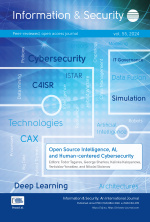Language Assistance to Multinational Partners in Coalition Operations
Source:
Information & Security: An International Journal,Keywords:
CALL, computer-assisted language learning, M-learning, medical terminology, vocabulary learning strategiesAbstract:
Knowledge of medical-related terminology and communication skills are essential for multinational partners participating in a wide variety of missions – combat, stabilization, humanitarian support and natural disaster relief. In case of injures and sickness they need to know basic medical terminology in English to evaluate the situation, arrange for MEDEVAC or coordinate health services. Although the First aid and MEDEVAC topics are included into many language training programs, participants are unable to use health-related vocabulary in challenging situations due to the lack of language practice and limited training time. The purpose of this study was to identify specific needs of the multinational partners in medical terminology, explore a range of technology-enhanced language learning strategies for vocabulary extension and refreshing, and suggest a framework for medical terminology assistance based on mobile learning. The study started with needs analysis to reveal specific language gaps and challenges in use of common medical terminology that may be addressed by individual mobile learning. It was intended to identify typical communication situations and vocabulary that should be addressed. Native and non-native English speakers from 14 NATO and partner countries (officers and civilians) who had participated in stability operations and other missions around the world were interviewed and answered a questionnaire. Additionally, five instructors who teach medical and health-related English to future mission participants were interviewed. As a result, three main areas of vocabulary were identified: parts of body, injuries and other health issues (feelings, symptoms), and medical assets/devices used for first aid and healthcare prescriptions. Most typical communication situations were related to car accidents, MEDEVAC calls, taking a person to the hospital, and writing a report about the accident. To identify the best way of exploiting mobile learning for language assistance to the multinational partners we focused on clarifying the differences between e-learning and m-learning and identifying specific features of m-learning that may be beneficial and even unique in supporting terminology acquisition for the multinational audience. Early research in m-learning emphasized limitations of the mobile devices, such as size of the display, reduced input, small memory, abridged or specific OS version, and lack of standards, which positioned m-learning as a specific case of e-learning. However, rapid evolution of mobile technologies, their recent features, including efficient and reliable tactile display, automated adjustment of the resolution and the like, put m-learning on an equal footing with e-learning. Moreover, as distribution of mobile devices significantly exceeds the number of personal computers, and “digital native” generation uses these devices extensively not only for communication but also for accessing information on the web, mobile access to e-learning content may increase several times in the near future. M-learning is perceived to be more flexible, more personalized, more interactive, and more engaging. Due to smaller portions of content and shorter learning session times, m-learning becomes a natural activity during transfer or waiting periods. Moreover, continuous use of the personal mobile device appeals to personalization of learning content through contextual and learning history relevancy. Integrating learning, communication, information exchange and assistance, mobile device became a natural enhancer/extender of the individuals’ capabilities. Extensive study of the literature on vocabulary learning strategies and their computer-based implementation suggested a range of learning activities useful for vocabulary acquisition. However, not all of them promise to be efficient in this specific case, as they do not address individual difficulties and initial vocabulary, short intervals of time that may be devoted to learning, limited attention to language learning due to other priorities, lack of translation to mother language. Moreover, most of the widely used vocabulary extension activities are reading-based, whereas video and audio samples are not properly tagged for share and reuse in vocabulary refreshing. Game-based and context-driven vocabulary acquisition strategies raise learning motivation but their efficiency compared to memorization-based approach has not been measured. In the final part of the study, requirements to the mobile learning environment for medical terminology support are formulated and examples of language learning activities for mobile devices are described.
